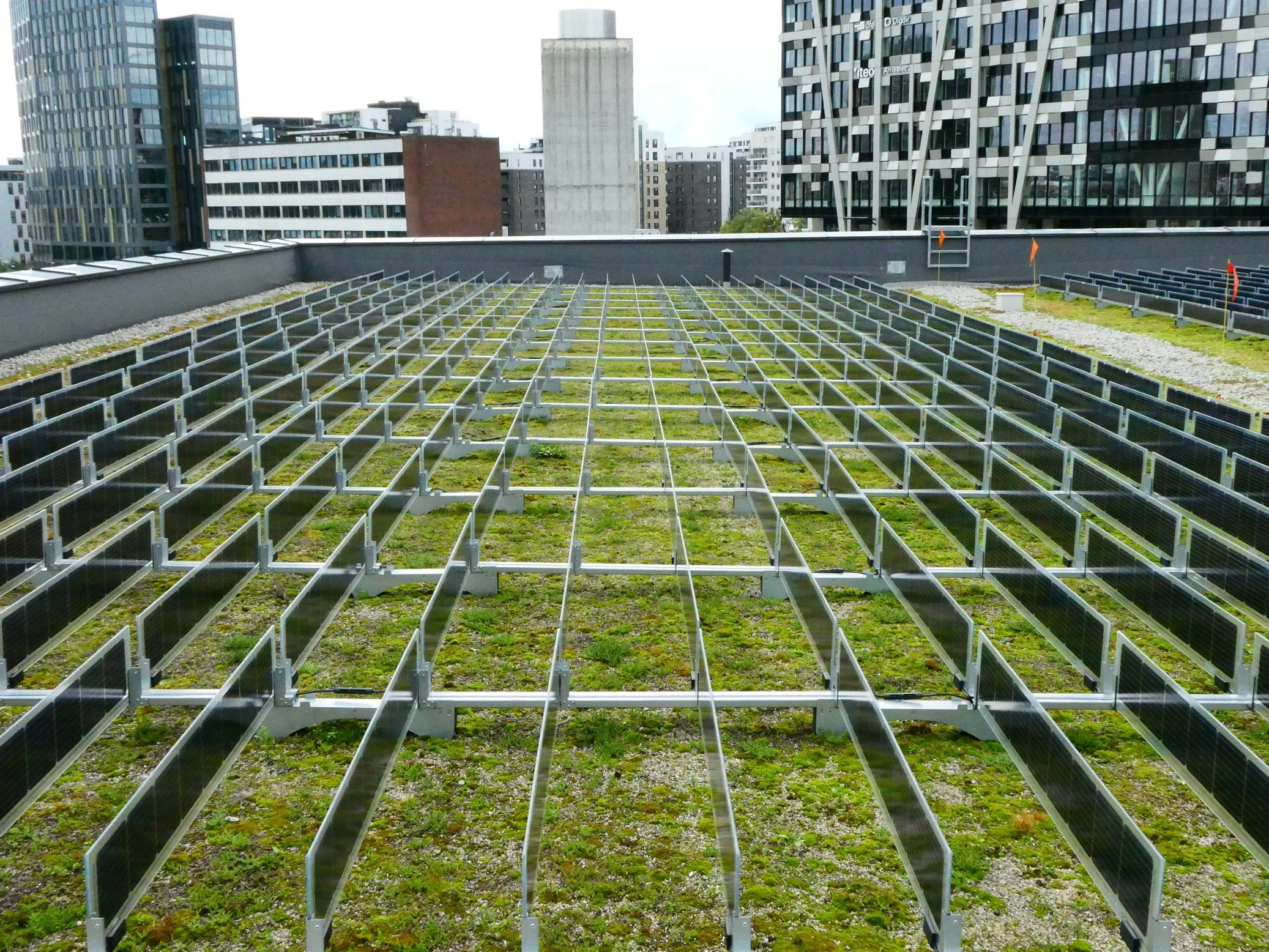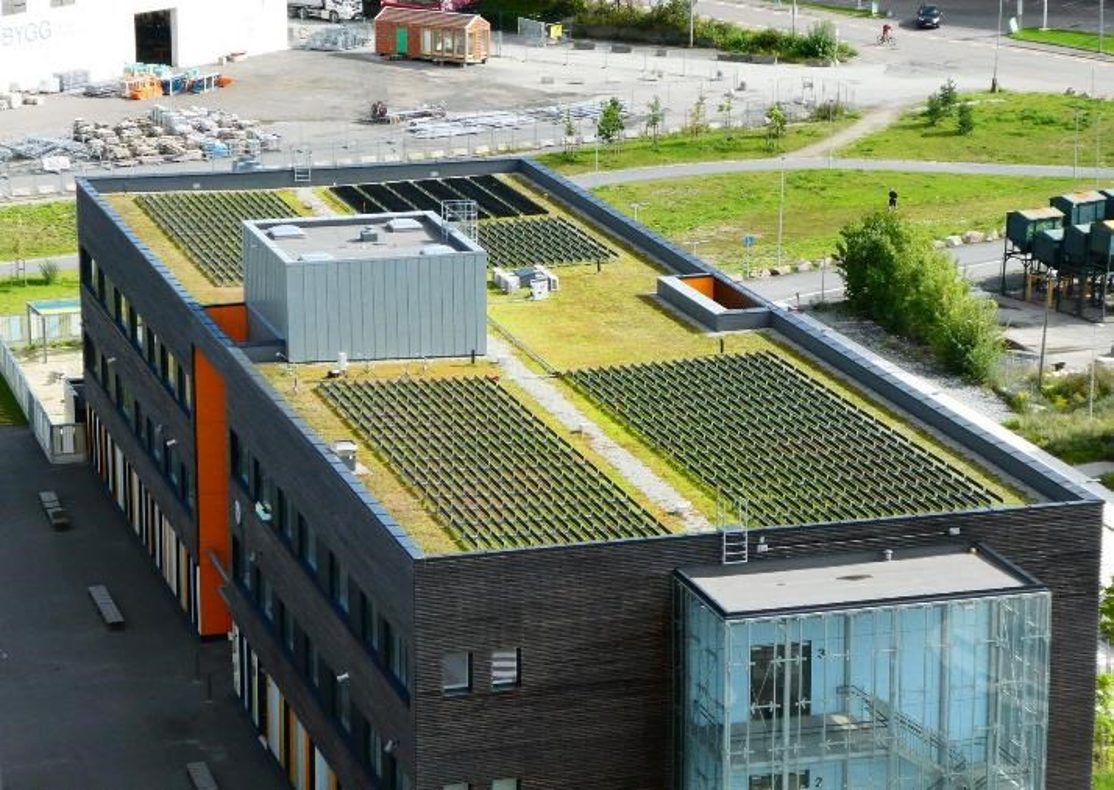New Innovations in Biosolar Technology
Advertisement
Vertical bifacial solar panels provides an open structure giving even light and rainwater distribution, and sedum is observed to thrive below the PV installation. Photo: Over Easy Solar
A vertical biosolar installation during winter in Oslo, Norway, a pilot financed by Oslo municipality in 2022. Photo: Over Easy Solar
The Winter 2022 issue of Living Architecture Monitor presented “The Battle for Surface Area” of roofs. We have all witnessed a vast majority of roofs being utilized exclusively for solar energy installations, for greening, or even worse for nothing! Perhaps this apparent conflict in development is due to limited knowledge or sharing of experience. Our experience in Norway is that our first pilots with biosolar roof projects have been a significant source of inspiration for further uptake and market development. The Municipality of Oslo has shown particular leadership, installing green roofs and biosolar roofs on covered waste treatment facilities, and more recently on schools and a new acute care walk-in medical clinic. We advise other municipalities to follow suit. As for the outcome of the battle, with good work from green infrastructure advocates we should expect a long period of harmony and peaceful collaboration between these two very compatible technologies - solar photovoltaics (PV) and green roofs.
Are biosolar roofs still considered innovative? The technology combination has been with us for about 25 years now, with early examples from the late 1990’s in Switzerland and Germany. The EU supported Biosolar roof project in 2014 contributed to rapid dissemination of knowledge and experience in Europe, notably to Scandinavia via The Scandinavian Green Roof Institute and pilots such as the Sofia apartments built by the Malmö public housing corporation, MKB Fastighet AB. While the combination of bio+solar is relatively new, the individual components are much older technologies. Edmund Becquerel is credited with discovering the photovoltaic effect in 1839. Green roofs have been with us here in Scandinavia for several millennia, in various forms. We should also recognize plants themselves as nature’s mind blowing biosolar innovation, harnessing the sun’s energy to draw water up from soil and producing and storing chemical energy.
Following early biosolar roof developments in Switzerland and Germany we have seen further innovations, such as work with “agrivoltaic” roofs done by Jennifer Bousselot and colleagues at Colorado State University, for example the pilot biosolarroof on the roof of the US Environmental Protection Agency Region 8 headquarters in Denver, Colorado. Their work has shown that, with proper design, solar panels can actually improve conditions for certain types of rooftop food production.
Advertisement
Maintenance Challenges
A recurring challenge met by owners of biosolar roof projects is the shading and disruption of photovoltaic production caused by unplanned vegetation growth, as documented by our friends at Livingroofs.org. Innovations to meet this challenge include differentiated nutrient values of substrates (gravel, without organic content) to discourage plant growth along the lower edge of the PV panels and elevating the panels to heights above the anticipated plant growth. Another approach is through careful substrate design and species selection, such as at the Daramu House project in Sydney, Australia. Innovations in bypass diodes and other module-level power electronics for controlling photovoltaic installations have reduced the extent of power loss caused by shading and cell disruption.
A full-scale vertical bifacial biosolar project of 45 kWp, installed in 2023. Photo: Over Easy Solar
Plants, Evapotranspiration and Energy Output
A well known synergy from combining photovoltaics with vegetation arises from the vegetation’s evapotranspiration and associated reduction of ambient air temperature. Low temperatures and reduced thermal radiation from an otherwise heated roof surface keep the solar panels cooler. This is important because higher panel temperatures come with reduced electrical output. We know that sedum species, in order to maintain hydration levels, halt evapotranspiration during periods of high solar exposure. This gives rise to concerns about the cooling contribution of sedum as a biosolar component. However, research documentation shows us that sedum also contributes to increased energy output. We also know that the albedo values of plants vary considerably. Further research and innovation is expected to lead to increased knowledge and improvements on vegetative contributions to reduced panel temperatures and hence, greater power output.
New Bifacial Solar Panel Advantages
Sedum growing on the green roof alongside the bifacial solar panels. Photo: Over Easy Solar
A rather radical development in photovoltaic technology from recent years, with innovation leadership from Switzerland, Germany and also Norway, is the development of bifacial solar panels. Rather than tilting the panels toward the sun for maximum solar gain on only one side, bifacial photovoltaics are usually installed vertically in a north to south orientation, with one side of the panel achieving maximum output during morning hours and the opposite side achieving maximum output in the afternoon. Together with the development of hourly or 15 minute differentiations in electricity pricing, bifacial photovoltaic production peaks offer a better correspondence with electricity price peaks and thus gain a competitive edge. Vertically oriented bifacial panels offer other advantages as well, allowing for close to 100% vegetated cover of the roof surface as opposed to panels that produce a large proportion of shaded areas with minimal vegetation. Bifacial panels have superior properties for dealing with wind forces as well. Wind tunnel tests conducted at I.F.I. Institute for Industrial Aerodynamics GmbH for the Norwegian biosolar startup OverEasy AS show that the panels don’t significantly respond to uplift from wind pressures, and thus reduce the need for ballasting that traditional sloped PV panels require. This makes bifacial biosolar solutions especially attractive for retrofit projects where the roof’s existing load bearing capacity will limit design options. The reduced need for ballasting also simplifies and reduces the time needed for installation of the photovoltaic panels.
Another advantage of bifacial biosolar roofs is the reduced tendency for gathering dust, pollen, bird droppings, snow etc. In winter conditions, the albedo increase from snow covering the roof vegetation will actually increase the photovoltaic output by directing more photons onto the panels.
As this article indicates, there are multiple considerations that come into play when designing a biosolar roof and also multiple opportunities for design failures. The World Green Infrastructure Network committed in November 2023 to produce strategic and technical guidance for designing and building biosolar roof installations. Under the leadership of WGIN co-founder Steven Peck, the first guidance document is planned for publication in 2024, to be followed with more detailed technical guidance in 2025.
At the tender age of 25 years, biosolar roof technology is surely still at the beginning of its innovation curve. The speed of nature’s innovation (evolution) with plants will hopefully continue at its slow but sure pace. The much higher speed of human innovations with advanced materials, efficiency increases and smart solutions within the photovoltaic realm will surely lead to new developments in biosolar roof solutions, so hang on to your seats.
Advertisement
David Brasfield is the Chairperson of the Norwegian Association for Green Infrastructure and Secretary of the World Green Infrastructure Network.








Ten diverse innovations in living architecture - ranging from technologies and research to project certification and policy - plus trends and recommendations for future endeavors.